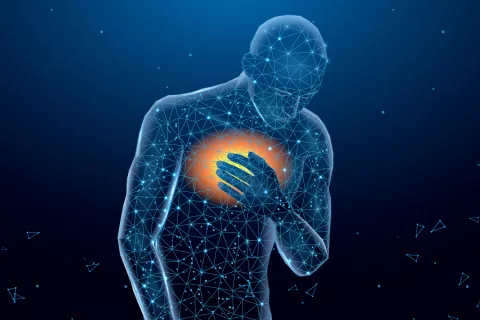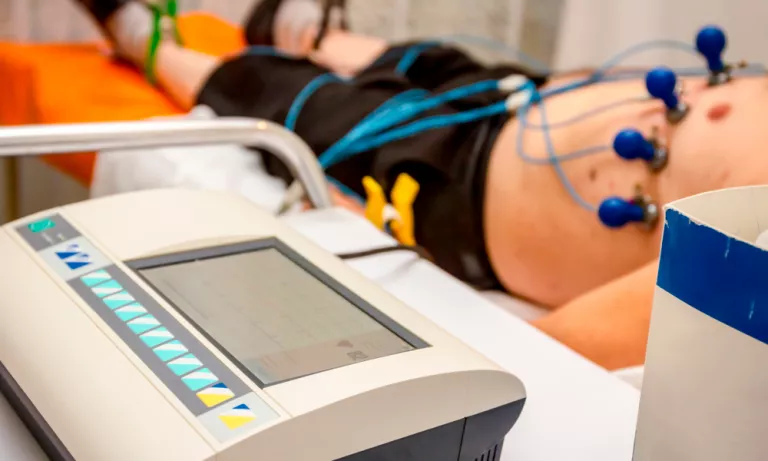
When we experience severe chest pain, the first thing that usually comes to mind is that it could be a heart attack, however, there are other conditions that cause similar discomfort and therefore it is convenient to know the characteristics that differentiate the associated pain. to a myocardial infarction –which is a medical emergency– from chest discomfort associated with other less serious pathologies.
“Chest pain is one of the most frequent reasons for consulting a doctor, especially in emergency services, and the most important thing is to rule out that it is a serious disease, especially cardiovascular disease. Fortunately, however, most patients who present for chest pain do not have any serious illness. In approximately 60% of cases, no specific pathology is identified, or the pain is related to musculoskeletal problems, and in 10% it is due to non-serious respiratory diseases,” says the Dr. Raul MorenoHead of the Cardiology Service of the La Paz University Hospital in Madrid.

How to distinguish heart attack pain from chest pain from other causes
“Typically, the pain produced by a heart attack is located in the upper part of the abdomen or in the front face of the chest, and sometimes also in the jaw or shoulders. It is important to keep in mind that pain in the left arm is rare, so the fact that our left arm hurts does not have to make us think that we are facing a heart attack. The pain can be like “a weight” or have other characteristics, but if it is “like a pinprick” it is rarely a heart attack. Likewise, if the pain increases or decreases in intensity with deep breathing or with posture, it is infrequent that it is a heart attack”, explains the Cardiology specialist.
That is, you have to suspect that it may be a heart attack:
- When someone who has a cardiovascular risk factor (smokers, or patients with high blood pressure, diabetes, or high cholesterol) has pain that lasts for more than 20-30 minutes
- That said pain is located in the upper part of the abdomen, in the chest, or even in the jaw
- That the pain is not a puncture and that it does not change in intensity with breathing or posture.
Faced with this situation, “we must always go to the health system to rule out a heart attack, especially by performing an electrocardiogram,” continues Raúl Moreno.

Causes of chest pain not related to a heart attack
In addition to a heart attack, “there are other diseases that can cause chest pain, “both other heart diseases and non-cardiac diseases,” says Dr. Moreno. “For example, the pain of angina pectoris is very similar to that of heart attack, but it only lasts a few minutes Another heart disease that can cause chest pain is pericarditis (inflammation of a membrane that surrounds the heart), but in this case the pain increases in intensity when the patient takes a deep breath. some non-cardiac diseases that cause chest pain (pathologies of the lungs or thorax bones) the pain changes in intensity with breathing or with posture”.
Below, we explain what are the most frequent diseases or conditions that can manifest with chest pain and when to worry about this symptom:
-
Angina pectoris: occurs when the heart does not receive enough blood flow, usually due to a blockage in the arteries. Although it is less serious than a heart attack, it also requires medical treatment.
-
Hiatal hernia: a stomach problem that in some cases causes pain in the thoracic area, which can be mistaken for a heart attack.
-
Gases: although they are harmless, they can trigger intense pain that can also be confused with heart-type pain.
-
Respiratory infections: especially when accompanied by cough. For example, some patients with COVID-19 have had costochondritis, a throbbing pain caused by inflammation of the cartilage that attaches the ribs to the breastbone, from a persistent dry cough.
-
Gastroesophageal reflux or GERD: causes heartburn – a burning or acidity sensation – at the level of the sternum when the stomach contents rise into the esophagus due to a failure in the mechanisms that should prevent it.
-
Stomach ulcer: some symptoms of peptic ulcer can be similar to those of a heart attack.
-
Muscle tension due to exercise: from having lifted weight or after adopting bad postures.
-
Aneurysm: is a dilation of an area of a blood vessel, which usually occurs in the aorta, and which can lead to a rupture of this with serious consequences. Symptoms of an aneurysm can also include abdominal pain.
-
Panic attack: this anxiety disorder can also be confused with a heart problem – palpitations, a feeling of shortness of breath, abdominal discomfort… – although in this case it is a tightness in the chest, not intense pain, and the symptoms of a panic attack are easier to differentiate because the affected person experiences a deep psychological discomfort.
In all of these cases, treatment of the disease or condition causing the patient’s symptoms will help prevent or alleviate pain and other discomfort.

Chest pain: warning signs for which you should see a doctor
“Among the symptoms that can accompany chest pain in a heart attack are shortness of breath, dizziness, nausea or even vomiting, sweating or just a general malaise. However, in a heart attack the key symptom is pain, and therefore the absence of other accompanying symptoms should never make us rule out that we are facing a heart attack”, warns Dr. Moreno.
The main symptoms that can accompany chest pain and that should be consulted with a doctor to rule out a serious health problem are:
- Oppressive and persistent pain, which does not vary (neither improves nor worsens) when changing posture, breathing, touching the area…
- The pain is located in the upper abdomen or chest, or radiates to the arms, neck or jaw.
- Having difficulty breathing.
- Pale.
- Having dizziness, nausea, or vomiting.
- high sweating
- Palpitations (more than 150 beats per minute or less than 40 at rest) or pins and needles in people with a history of angina or heart attack.
- The pain appears after exercising.

In addition, as the head of the Cardiology Service of La Paz affirms, “in women, the diagnosis of a heart attack can sometimes be somewhat more difficult, partly because it is thought that a heart attack is a disease almost exclusively for men, and This in the face of heart attack symptoms sometimes takes longer to suspect that we are facing a heart attack if it is a woman. On the other hand, although the symptoms are basically similar in men and women, sometimes the type of pain is less specific and intense in women.
However, he adds, “it must be remembered that this disease has higher mortality in women than in men, so a woman with a cardiovascular risk factor who has symptoms compatible with a heart attack always has to see a doctor to rule out this disease.” ”.
Dr. Moreno concludes that “a person who has some risk factor (smoking, high blood pressure, elevated cholesterol or diabetes) and who has pain in the upper part of the abdomen or chest that is not a “puncture” type and that does not change with breathing or movement, you should always consult a doctor to rule out a heart attack.
.